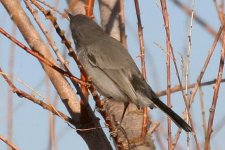Fulmar
Well-known member
Any Californians, or others familiar with these birds, can identify the bird in the attached photo? As always (you know that) the bird just turned its head when I made the photo, and before I could make a second one, it had disappeared into the brush and didn't reappear again (that sounds familiar too?).
For the ID I have come as far as a Gnatcatcher, but which one? The photo was made in the brush along the New River at Fig Lagoon, a bit west of El Centro, Imperial County, California. I think three species of Gnatcatcher could appear there, the Black-tailed, the California, and the Blue-gray. Unfortunately I didn't see the underside of the tail which would have revealed all, but maybe some of you familiar with them recognize it anyway? The photo was made February 15.
Thanks for your help,
Peter
For the ID I have come as far as a Gnatcatcher, but which one? The photo was made in the brush along the New River at Fig Lagoon, a bit west of El Centro, Imperial County, California. I think three species of Gnatcatcher could appear there, the Black-tailed, the California, and the Blue-gray. Unfortunately I didn't see the underside of the tail which would have revealed all, but maybe some of you familiar with them recognize it anyway? The photo was made February 15.
Thanks for your help,
Peter






